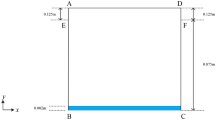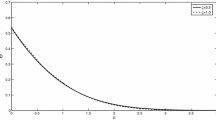Abstract
An integrated fluid-thermal-structural analysis approach is presented. In this approach, the heat conduction in a solid is coupled with the heat convection in the viscous flow of the fluid resulting in the thermal stress in the solid. The fractional four-step finite element method and the streamline upwind Petrov-Galerkin (SUPG) method are used to analyze the viscous thermal flow in the fluid. Analyses of the heat transfer and the thermal stress in the solid are performed by the Galerkin method. The second-order semiimplicit Crank-Nicolson scheme is used for the time integration. The resulting nonlinear equations are linearized to improve the computational efficiency. The integrated analysis method uses a three-node triangular element with equal-order interpolation functions for the fluid velocity components, the pressure, the temperature, and the solid displacements to simplify the overall finite element formulation. The main advantage of the present method is to consistently couple the heat transfer along the fluid-solid interface. Results of several tested problems show effectiveness of the present finite element method, which provides insight into the integrated fluid-thermal-structural interaction phenomena.
Similar content being viewed by others
Abbreviations
- g :
-
gravitational acceleration
- Gr :
-
Grashofnumber, Gr = gβ T (T h − T c)L 3/ν 2 (ratio of buoyancy to viscous force)
- k :
-
thermal conductivity
- Nu :
-
local Nusselt number (ratio of convective to conductive heat transfer across (normal to) boundary)
- \(\overline {Nu}\) :
-
average Nusselt number
- Pe :
-
Pecletnumber
- p :
-
fluid pressure
- Pr :
-
Prandtl number, Pr = ν/α (ratio of momentum diffusivity (kinematic viscosity) to thermal diffusivity)
- \(\tilde Q\) :
-
heat generation per unit volume
- Re :
-
Reynolds number, Re = ρυd/µ (ratio of inertial force to viscous force)
- t :
-
time
- T :
-
temperature
- u 1 :
-
velocity component in the x-direction
- u 2 :
-
velocity component in the y-direction
- υ 1 :
-
solid displacement in the x-direction
- υ 2 :
-
solid displacement in the y-direction
- x :
-
horizontal distance
- y :
-
vertical distance
- α :
-
thermal diffusivity, α = k/ρc
- α sf :
-
solid-to-fluid thermal diffusivity ratio, α sf = α s/α f
- β f :
-
thermal expansion coefficient
- K sf :
-
solid-to-fluid thermal conductivity ratio, K sf = k s/k f
- ν :
-
kinematic viscosity, ν = μ/ρ
- ρ :
-
density
- i, j :
-
nodal quantities
- int:
-
interface
- o:
-
cold surfaces
- f:
-
fluid
- s:
-
solid
References
Misra, D. and Sarkar, A. Finite element analysis of conjugate natural convection in a square enclosure with a conducting vertical wall. Computer Methods in Applied Mechanics and Engineering, 141, 205–219 (1997)
Malatip, A., Wansophark, N., and Dechaumphai, P. Combined streamline upwind Petrov-Galerkin method and segregated finite element algorithm for conjugated heat transfer problems. Journal of Mechanical Science and Technology, 20(10), 1741–1752 (2006)
Malatip, A., Wansophark, N., and Dechaumphai, P. A second-order time-accurate finite element method for analysis of conjugate heat transfer between solid and unsteady viscous flow. Journal of Mechanical Science and Technology, 23(3), 775–789 (2009)
Al-Amiri, A., Khanafer, K., and Pop, I. Steady-state conjugate natural convection in a fluidsaturated porous cavity. International Journal of Heat and Mass Transfer, 51, 4260–4275 (2008)
Schäfer, M. and Teschauer, I. Numerical simulation of coupled fluid-solid problems. Computer Methods in Applied Mechanics and Engineering, 190, 3645–3667 (2001)
Brooks, A. N. and Hughes, T. J. R. Streamline upwind/Petrov-Galerkin formulations for convection dominated flows with particular emphasis on the incompressible Navier-Stokes equations. Computer Methods in Applied Mechanics and Engineering, 32, 199–259 (1982)
Zienkiewicz, O. C., Taylor, R. L., and Nithiarasy, P. The Finite Element Method for Fluid Dynamics, 6th ed., Elsevier, Oxford (2005)
Dechaumphai, P. Finite Element Method: Fundamentals and Applications, Alpha Science International, Oxford (2010)
Choi, H. G., Choi, H., and Yoo, J. Y. A fractional four-step finite element formulation of the unsteady incompressible Navier-Stokes equations using SUPG and linear equal-order element methods. Computer Methods in Applied Mechanics and Engineering, 143, 333–348 (1997)
Kim, J. and Moin, P. Application of a fractional step method to incompressible Navier-Stokes equations. Journal of Computational Physics, 59, 308–323 (1985)
Chen, X. and Han, P. A note on the solution of conjugate heat transfer problems using SIMPLElike algorithms. International Journal of Heat and Fluid Flow, 21, 463–467 (2000)
Davalath, J. and Bayazitoglu, Y. Forced convection cooling across rectangular blocks. Journal of Heat Transfer, 109, 321–328 (1987)
Hriberšek, M. and Kuhn, G. Conjugate heat transfer by boundary-domain integral method. Engineering Analysis with Boundary Elements, 24, 297–305 (2000)
Wansophark, N., Malatip, A., and Dechaumphai, P. Streamline upwind finite element method for conjugate heat transfer problems. Acta Mechanica Sinica, 21(5), 436–443 (2005)
Author information
Authors and Affiliations
Corresponding author
Rights and permissions
About this article
Cite this article
Malatip, A., Wansophark, N. & Dechaumphai, P. Fractional four-step finite element method for analysis of thermally coupled fluid-solid interaction problems. Appl. Math. Mech.-Engl. Ed. 33, 99–116 (2012). https://doi.org/10.1007/s10483-012-1536-9
Received:
Revised:
Published:
Issue Date:
DOI: https://doi.org/10.1007/s10483-012-1536-9




